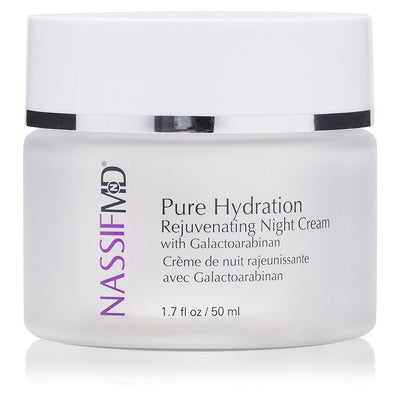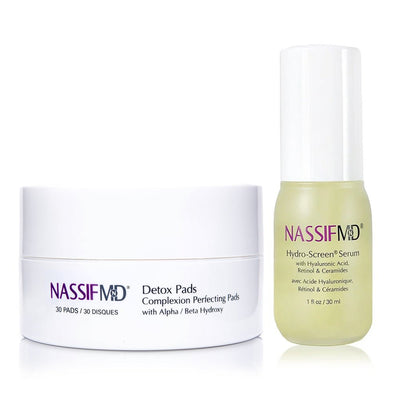What’s the Difference Between BHA and AHA?
Alpha hydroxy acids (AHA) and beta hydroxy acids (BHA) are popular chemical exfoliants added to a variety of skincare products. Both are highly effective at removing dead skin and promoting cellular turnover to produce a youthful appearance, but what’s the difference between AHA and BHA?
Today’s article will dive into the science of AHA vs. BHA and answer your most pressing questions, such as:
- What is AHA?
- What does AHA do?
- What is BHA?
- What does BHA do?
- What’s better? BHA vs. AHA
- Can you use AHA and BHA together?
- How should I use AHA and BHA in my skincare routine?
We’ll also explore NassifMD® Detox Facial Pads to effectively use hydroxy acids at home for maximum results.
What is AHA? Alpha Hydroxy Acid
Alpha hydroxy acids (AHA) are a group of naturally occurring compounds that exfoliate the skin and promote cellular turnover. The skin naturally sloughs off dead cells to reveal new skin cells underneath, but especially with age, this process needs some help to reveal the healthy complexion you desire. AHA skincare does just that!
AHAs are water-soluble compounds that work on the skin’s surface to “unglue” the bonds holding dead skin cells in place, allowing them to release. Benefits of an AHA exfoliant include:
- Improve skin texture and tone (link to texture and tone article)
- Minimize fine lines and wrinkles
- Decrease the appearance of pores
- Increase skin firmness
- Promote hydration
- Stimulates collagen production
- Allow skincare products to penetrate more deeply for better results
AHA for skin treatments include:
- Glycolic acid
- Lactic acid
- Mandelic acid
- Phytic acid
Glycolic acid is a natural alpha hydroxy acid from fruit. It’s naturally antibacterial, helps the skin maintain a healthy pH, and prevents acne.
Lactic acid is a natural alpha hydroxy acid produced by beneficial bacteria (lactobacillus) that live on the skin. Lactic acid inhibits melanin production, so it’s a good choice for sun-damaged or hyperpigmented skin.
Exfoliant for Dry Skin
Alpha hydroxy acids are suitable for all skin types and particularly beneficial for dry skin because of their hydrating properties. If your skin is dry and aging, acne-prone, or sun-damaged, AHA skin products can help restore a radiant, youthful appearance.
Breaks Down Dead Skin Cells
Your skin cells are constantly regenerating in a process called cellular turnover. New skin cells preplace old and damaged cells. Exfoliators, like AHAs, help remove dead skin cells, debris, and impurities sitting on the skin’s surface (the epidermis). They help unclog pores and expose the younger skin below, improving its appearance and glow.
Use AHA Before Moisturizing
AHAs can stay on the skin; they don’t need to be washed off. Use them in your skincare routine before moisturizing. Here are some suggestions for use:
- In your daily cleanser – try NassifMD® Purifying Glycolic Facial Cleanser with glycolic acid
- In the best-selling NassifMD® Detox Facial Pads with glycolic and lactic acids (more on detox pads below)
- In your retexturizing treatment – try NassifMD® Even, Correct & Renew Retexturizing Treatment Pads with mandelic acid. Read more about them here.
What is BHA? Beta Hydroxy Acid
Beta hydroxy acids (BHA) are another group of naturally occurring hydroxy acids that promote exfoliation when applied topically to the skin. Because of a slightly different chemical composition, BHAs are fat-soluble and penetrate the skin more deeply. BHAs also have calming properties.
BHA benefits are like those discussed with AHAs. They exfoliate, remove dead skin cells, promote cellular turnover, and improve the appearance of fine lines, wrinkles, pores, skin texture, and tone.
The most common BHA exfoliant in BHA skincare is salicylic acid. Derived from the willow plant, salicylic acid is used in skincare products to reduce inflammation and treat various skin conditions, including acne. It’s gentle and likely the best BHA exfoliant for oily or acne-prone skin.
Exfoliant for Oily Skin and Acne
AHAs tend to be better for dry skin, while BHAs tend to work better for oily skin and skin prone to blemishes. It’s gentle enough for sensitive skin yet still effective for removing debris, dead skin cells, and impurities from pores. The anti-inflammatory effects also help prevent acne flares.
Penetrates Pores to Clear Blemishes
As mentioned, exfoliating with BHAs like salicylic acid penetrates deeper skin layers. AHAs primarily only reach the outer skin layer, the epidermis. This deeper action works well for clearing out pores, which helps prevent acne and produces a smoother skin texture and appearance.
Use BHA Before Moisturizing
You can use BHA skincare much like you’d use AHA skincare: after cleansing and before moisturizing.
Read Order of Application: Step-By-Step Skin Routines to learn where your favorite BHA products fit, whether an acne spot treatment or NassifMD® Detox Facial Pads.
Is BHA or AHA Better?
When choosing AHA or BHA, one isn’t better than the other. It depends on your skin type. In general, if you have dry skin, try AHAs. BHAs are better suited for oily skin. Although for combination skin or anti-aging benefits, there are benefits to both, and you may not fall strictly into one category.
What’s Your Skin Type?
To learn more about your skin type and whether to exfoliate with BHA or certain AHAs, please read How to Find the Perfect Exfoliator for Your Skin Type.
Can I Use BHA and AHA Together?
The truth is that you don’t have to choose one or the other. Many people will benefit from using AHAs and BHAs together. That’s exactly what you’ll find in NassifMD® Detox Facial Pads!
Research also suggests that AHAs and BHAs can be used together and combined with other active ingredients for advanced results. When using AHA and BHA products together, you can adjust the frequency of use for your skin type.
NassifMD® Detox Facial Pads go beyond exfoliation; they combine proven skincare ingredients in a synergistic formula for unparalleled results. In this multi-tasking formula you exfoliate, nourish, hydrate, and protect the skin. It’s no wonder detox pads have so many benefits, they were developed by Dr. Nassif, a facial plastic and reconstructive surgeon with a deep understanding of skin health.
Each detox pad contains these active ingredients:
- Glycolic acid (AHA)
- Lactic acid (AHA)
- Salicylic acid (BHA)
- Witch hazel
- Vitamin C
- Bakuchiol
Together, these ingredients:
- Remove dirt, makeup, impurities, and dead skin cells
- Deeply cleanse and tone the skin
- Gently exfoliate and even skin texture
- Improves the appearance of fine lines and wrinkles
Read more about the benefits of detox pads in Why Detox Pads Should Be a Staple in Everyone’s Skincare Routine.
Order of Application
Use NassifMD® Detox Facial Pads after cleansing or in place of a facial cleanser as the first or second step in your skincare routine. Don’t rinse off and follow with the rest of your skincare routine.
For dry or sensitive skin, begin with detox pad treatments two or three times per week. As your skin adjusts, you can use them more frequently. If you have normal or combination skin, begin with three times per week and work up to daily use. For oily skin, use detox pads once or twice daily.
When using AHA and BHA skincare, it’s essential to use sunscreen every day. The increased cellular turnover can make your skin more sensitive to sun damage, and it will benefit from increased and diligent protection.
AHA and BHA are natural compounds that greatly benefit skin health, especially in synergy with other active ingredients in NassifMD® facial plastic surgeon skincare. With your understanding of the differences between AHAs and BHAs, you can tailor your use to your skin type or get the best of both worlds with NassifMD® Detox Facial Pads.
References
- Valle-González, E. R., Jackman, J. A., Yoon, B. K., Mokrzecka, N., & Cho, N. J. (2020). pH-Dependent Antibacterial Activity of Glycolic Acid: Implications for Anti-Acne Formulations.Scientific reports, 10(1), 7491.
- Bhardwaj, V., Sharma, K., Maksimovic, S., Fan, A., Adams-Woodford, A., & Mao, J. (2021). Professional-Grade TCA-Lactic Acid Chemical Peel: Elucidating Mode of Action to Treat Photoaging and Hyperpigmentation.Frontiers in medicine, 8, 617068.
- Liu, H., Yu, H., Xia, J., Liu, L., Liu, G. J., Sang, H., & Peinemann, F. (2020). Topical azelaic acid, salicylic acid, nicotinamide, sulphur, zinc and fruit acid (alpha-hydroxy acid) for acne.The Cochrane database of systematic reviews, 5(5), CD011368.
- Green, B. A., Yu, R. J., & Van Scott, E. J. (2009). Clinical and cosmeceutical uses of hydroxyacids.Clinics in dermatology, 27(5), 495–501.






















